Ask AI on The Internet
Question: QUESTION 4 (37) 4.1 Examine the Grade R daily programme in the study guide and develop two teacher-guided activities that you can plan for art under the theme of weather. (6) 4.2 Draw a basic classroom layout showing interest areas for activities such as block play, art, and pretend play. (7) 4.3 Read the statement below and answer the question that follows. The study guide outlines the basic principles of chid development. These principles inform how we teach young children using an approach known as developmentally appropriate practice. In view of the statement, draw a table with two columns and, in the first column, write down five principles of child development (5). In the second column, evaluate the importance of each principle (10). Below is an example of the table. (15) Principle Importance of each principle 1 2 3 …. Continue until 5 4.4 Recommend two art activities to support the social development of Grade R learners. (2 X 3) (6) 4.5 Define the term “developmentally appropriate practice”. (2) QUESTION 5 (12) 5.1 Evaluate the importance of each of the following three roles of a teacher during art lessons. (4 X 3) (12) Teacher’s role Importance of the role (mention two points) 1 Observer 2 Assessor 3 Recorder
Certainly! Here are the answers to the specified questions: ### QUESTION 4 #### 4.1 Two Teacher-Guided Art Activities under the Theme of Weather 1. **Weather Mural Creation** - **Activity Description:** Divide the class into small groups and assign each group a different type of weather (sunny, rainy, snowy, windy). Each group uses various art materials to create a mural representing their assigned weather. For example, the sunny group could use yellow paint, paper plates for the sun, and cotton for fluffy clouds. - **Objective:** To foster teamwork, creativity, and an understanding of different weather conditions. - **Materials Needed:** Large butcher paper, paints, paper plates, cotton balls, markers, crayons, glue, scissors. 2. **Weather Collage** - **Activity Description:** Have the children create a collage using magazine cutouts, colored paper, and various art supplies to represent different weather types. They can arrange their collage on a large piece of construction paper and label the different weather types. - **Objective:** To develop fine motor skills, enhance creativity, and learn about weather patterns. - **Materials Needed:** Old magazines, colored construction paper, glue sticks, scissors, markers. #### 4.2 Basic Classroom Layout Showing Interest Areas Below is a basic sketch of a classroom layout. Since I can't draw, I'll describe it: - **Entry Area:** - **Cubbies/Storage for Personal Items** - **Center Classroom:** - **Circle Time Area** with a rug and a teacher's chair. - **Left Side:** - **Block Play Area:** Blocks, building materials. - **Middle:** - **Art Area:** Easels, tables, paint, craft supplies. - **Right Side:** - **Pretend Play Area:** Play kitchen, costumes, dolls, and puppets. - **Back Wall:** - **Reading Nook:** Bookshelves, comfortable seating. - **Science/Discovery Area:** Magnifying glasses, plants, small creatures. - **Near Window:** - **Sensory Table/Water Play:** Sand, water, sensory materials. This layout ensures that children have distinct areas to engage in various activities, fostering a structured and stimulating environment. #### 4.3 Table of Principles and Importance | **Principle** | **Importance of Each Principle** | |-------------------------------------------------|----------------------------------------------------------------------------------------------------------------------------------------------------------------------------| | 1. Developmentally Appropriate Practices | Ensures activities are suitable for the age and stage of development, promoting optimal learning and growth. | | 2. Holistic Development | Recognizes the interconnectedness of physical, cognitive, social, and emotional development, ensuring well-rounded education. | | 3. Individual Variability | Acknowledges that each child develops at their own pace, encouraging personalized learning approaches. | | 4. Play as a Central Role in Learning | Emphasizes the importance of play in developing critical thinking, social skills, and creativity. | | 5. Positive Relationships and Interactions | Highlights the role of secure, supportive relationships in fostering a conducive learning environment. | #### 4.4 Two Art Activities to Support Social Development 1. **Collaborative Mural Painting** - **Description:** Children work together to paint a large mural. They discuss and decide on a theme, and each child contributes to different sections of the mural. - **Objective:** Encourages teamwork, communication, and cooperative skills. 2. **Group Art Projects with a Shared Theme** - **Description:** Small groups work on creating art pieces with a common theme (e.g., a neighborhood, a park). Each group plans and decides on the elements they will include in their artwork. - **Objective:** Fosters collaboration, negotiation, and social interaction among peers. #### 4.5 Definition of “Developmentally Appropriate Practice” **Developmentally Appropriate Practice** (DAP) refers to educational methods and practices that align with the typical development and individual needs of children at various ages and stages. DAP takes into consideration knowledge of child development, each child's individual strengths and needs, and the social and cultural context in which the child is growing. ### QUESTION 5 #### 5.1 Importance of Teacher's Roles During Art Lessons | **Teacher’s Role** | **Importance of the Role** | |--------------------|-------------------------------------------------------------------------| | 1. **Observer** | 1. Allows for assessment of each child’s progress and development. | | | 2. Identifies individualized support or enrichment opportunities needed for each child. | | 2. **Assessor** | 1. Provides insights into the child's understanding and application of concepts. | | | 2. Helps in planning future activities tailored to students' needs and interests. | | 3. **Recorder** | 1. Documents children’s developmental milestones and achievements, which are crucial for reporting to parents and planning further activities. | | | 2. Maintains a record of each child’s work and progress over time, helping to highlight growth and areas needing attention. | These answers should help you create a comprehensive understanding of the topics and provide a structured foundation for your work.
Think your answer is better than the AI's? Post it below.
Question Tags
If you want your question answered by an AI, click here.







Post your own comment: